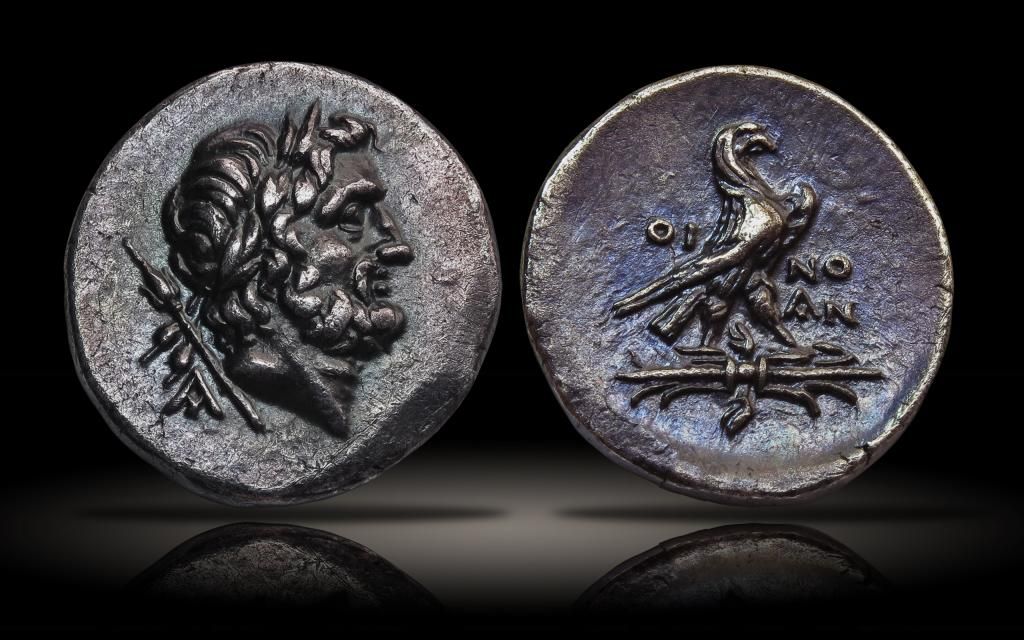Options
The Enigma of Oinoanda

Oinoanda, an ancient Greek city located in the upper valley of the Xanthus River, was built on the top of a high mountain in the ancient province of Lycia, now modern southwest Turkey. Little is known of the early history of the settlement in spite of several exploratory surveys which have been carried out in the region.
It was a substantial city in antiquity but surprisingly, it issued its own silver coins at only one moment in its long history. Until the early 2000s, the coinage was known from only a single specimen acquired by the British Museum in 1897. The discovery of a small group has allowed the coinage to be studied in much more detail and has added to our admittedly sparse understanding of the coinage of the period.
Three distinct issues have been identified, marked by a sequence of letters and symbols. They are dated to the first three years of Attalid rule of the region following the peace of Apameia in 188 BC after the Roman defeat of Antiochos III in 190 BC. The terms of the peace dictated that much of the Seleukid territory in Anatolia passed to the control of Pergamon and Rhodes.
Because of this, Oinoanda was able to establish sufficient autonomy to begin to mint its own coinage. It is apparent due to the wide variety in coin weight that the mint did not have experience in quality control, but each of the coins were intended to be Attic didrachms, weighing about 8.65 grams.
Contrary to the very prevalent drachm and tetradrachms in the region, didrachms were an unusual denomination. It has been theorized that this weight was chosen for streamlined exchange between the Attic weight and the new cistophoroi of the Attalids, with three Oinoandan didrachms equaling two cistophoric tetradrachms.
With both cistophoric and Attic coinages being used in Oinoanda, the didrachm would make it easier to handle official payments to the Attalid authorities and deal with local and nearby territories still on the Attic standard.
The underlying purpose for this rare and isolated coinage is still unclear but it may have been minted to pay for the Hellenistic city walls built during the period after the formal Attalid takeover. However, the four known obverse dies would have produced a substantially insufficient quantity of coins to pay for such a large undertaking, indicating that unless more dies are discovered in the future, the difference may have been funded by the cistophoroi or Side tetradrachms which circulated in the region.
Zeus was the principal deity of Oinoanda and he is depicted on the obverse of this coin with a lotus-tipped scepter over his shoulder. His eagle is shown standing to the right on a winged thunderbolt on the reverse. The design appears to have been influenced in part by the Ptolemaic Kingdom of Egypt, sharing similar attributes, but clearly deviating in actual execution.
This coin is the finest of only four known from the first die pair in the series, marking it as one of the first coins struck by Oinoanda and placing it at the beginning of an enigmatic and aesthetic coinage that historians are still learning from today.
LYCIA, Oinoanda. 188 BC. AR Didrachm (19mm, 7.92 g, 12h). Laureate head of Zeus right; A and scepter behind / Eagle standing right on winged thunderbolt. Ashton, Oinoanda 1 (A1/P1), otherwise unpublished. EF, dark iridescent toning. Well centered and sharply struck from the first die pairing of the series. Extremely rare and the finest of the four known from these dies.
Learn about our world's shared history told through the first millennium of coinage: Colosseo Collection
0
Comments
World Collection
British Collection
German States Collection
Taler Custom Set
Ancient Custom Set
A great read and an interesting beautifully toned RARE coin
Very cool
--Severian the Lame
Because I was not familiar with Oinoanda I had to do a search on it. I found something fascinating. Oinoanda was the home of Diogenes, an apparently wealthy man, who, and I quote from the website:
In an event both genial and eccentric, spends his entire fortune to erect a wall, eighty metres long by four high to the portico of the city, where he made to engrave several texts to present the main tenets of philosophy that has made his life happy: Epicureanism.
With this extraordinary gift, Diogenes of Oinoanda wanted to share not only with his citizens but also all the inhabitants of Lycia, and even foreigners, the philosophy that ensures the true happiness and frees men from fear of the gods and death."
Here is that site devoted to Diogenes, Oinoanda and Epicurean philosophy.
DIOGENES OF OINOANDA, THE EPICUREAN INSCRIPTION
It's for the associated history like this, and that SmEagle1795 wrote in his post, that I collect coins. I love to learn about the lives of ancient people in general and specific persons especially.
A great coin from many respects.
https://www.civitasgalleries.com
New coins listed monthly!
Josh Moran
CIVITAS Galleries, Ltd.